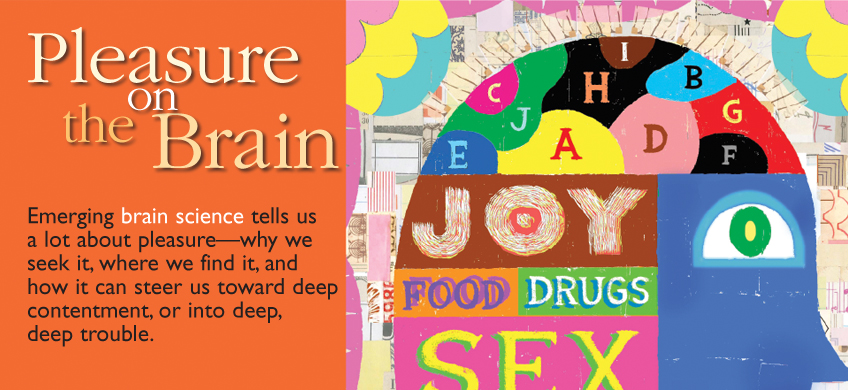
(page 2 of 3)
So, researchers who delve into the basic biological sciences sidestep “happiness” entirely. “We can’t get to happiness,” says David Linden, a professor of neuroscience at the School of Medicine. “We know that there are places in the brain that will tell us the existence of pleasure, whether it’s hard-wired or not. There’s no neurophysiological correlate for happiness. We don’t know where in the brain its structure or activity lies.” Because pleasure—which Linden calls “the kid brother of happiness”—lights up the room like a buxom belle or a buff bachelor at the ball, it announces itself ripe for inspection.
Linden doesn’t research pleasure himself—his work focuses on the ins and outs of subconscious motor learning and memory—but he’s gladly assumed the role of popularizer of the brain and why it is what it is, first in his 2006 book, The Accidental Mind: How Brain Evolution Has Given Us Love, Memory, Dreams, and God, and in the forthcoming The Compass of Pleasure: How Our Brains Make Fatty Foods, Orgasm, Exercise, Marijuana, Generosity, Vodka, Learning, and Gambling Feel So Good, which will be released by Viking Press in the spring. With his graying hair pulled back from a broad forehead and banded into a ponytail, and while sporting a Central American guayabera and wire frame specs, Linden looks a bit like Jerry Garcia’s kid brother, someone who may have had some experience with several types of “pleasure” over the years.
Linden will tell you that unless we’re afflicted by Parkinson’s disease or other disorders that mess with our circuitry, we’re all fellow travelers on the path to pleasure. “There’s a rich database of brain imaging out there now that tells us that there’s a central brain circuit, and that it’s activated by every form of pleasure we know,” Linden says. What’s more, our pleasure systems have developed so that they do more than help guide us in a way that befits evolution. We can drink, ingest, inject, smoke, or snort substances that hijack our circuitry and offer us temporary transcendence, as well as the morning after, though we don’t remember that anywhere near as readily as we do the high. Thinking abstract thoughts and meditating can also tickle our mental fancy. It appears that learning itself can give us a predictable rush. Apparently, evolution has rewarded us for learning to behave and think in certain ways by giving us a momentary “high” when we put the proverbial two and two together.
“The pleasure circuit lights up when you take a bite of delicious food, have an orgasm, or use alcohol, tobacco, heroin, cocaine, or amphetamine, or when you’re taking part in virtuous behaviors like giving money to charity,” Linden says. “It’s all the same system.”
Pleasure functions as a linchpin in many of our brain schemes, albeit one that we have to police a bit. Because of the way evolution built our brains, pleasure works hand in hand with our associative memory. It’s why we tap our foot to that Captain and Tennille ditty we first heard at the dance where we met a now long-lost sweetheart, even though we usually have better taste in music. Since pleasure and learning are linked, scientists refer to pleasure as “reward,” something that shapes much of our behavior and can be measured in experiments on humans and rodents. We often work to learn how to repeat behaviors that set off clumps of neurons and the neurotransmitters, primarily dopamine, that flood several parts of our brain with a heady sensation—our gratifying reward for performing a certain act.
As you might expect, the pleasure circuit doesn’t reside in the top of the brain, where we do much of our thinking and reasoning. Instead, it’s deep in the center, where its influence can be felt in many regions of gray matter. “You’re closer to it if you go through the roof of the mouth than through the top of your head,” advises Linden. He compares the brain’s structure to dessert making. As our brains evolved, they added new parts, kind of like adding an extra scoop to an ice cream cone. Pleasure developed in several scoops early and often. Foremost among them is the ventral tegmental area, or VTA, where brief electrical impulses run along information-carrying fibers called axons. Curiously, some of the VTA’s axon terminals exist in an entirely separate region called the nucleus accumbens. When electrical impulses reach the axon terminals, they release dopamine—the dope of the mind, the substance that makes us happy, at least temporarily.
Through a complex set of interactions, dopamine molecules and receptors also trigger responses in the amygdala, a brain region that regulates fear, and the anterior cingulated cortex, an emotion center. Dopamine-based reactions also occur in the dorsal striatum, the center of habit learning. Other VTA neurons send dopamine-releasing axons to the hippocampus, our repository of memories regarding facts and events. (Cue up “Love Will Keep Us Together.”) Meanwhile, even more of those feel-good axons head toward the prefrontal cortex, our center for judgment and planning. All of these outposts in the brain also get infusions of glutamate, another hopped-up neurotransmitter, by way of something called the medial forebrain bundle.
